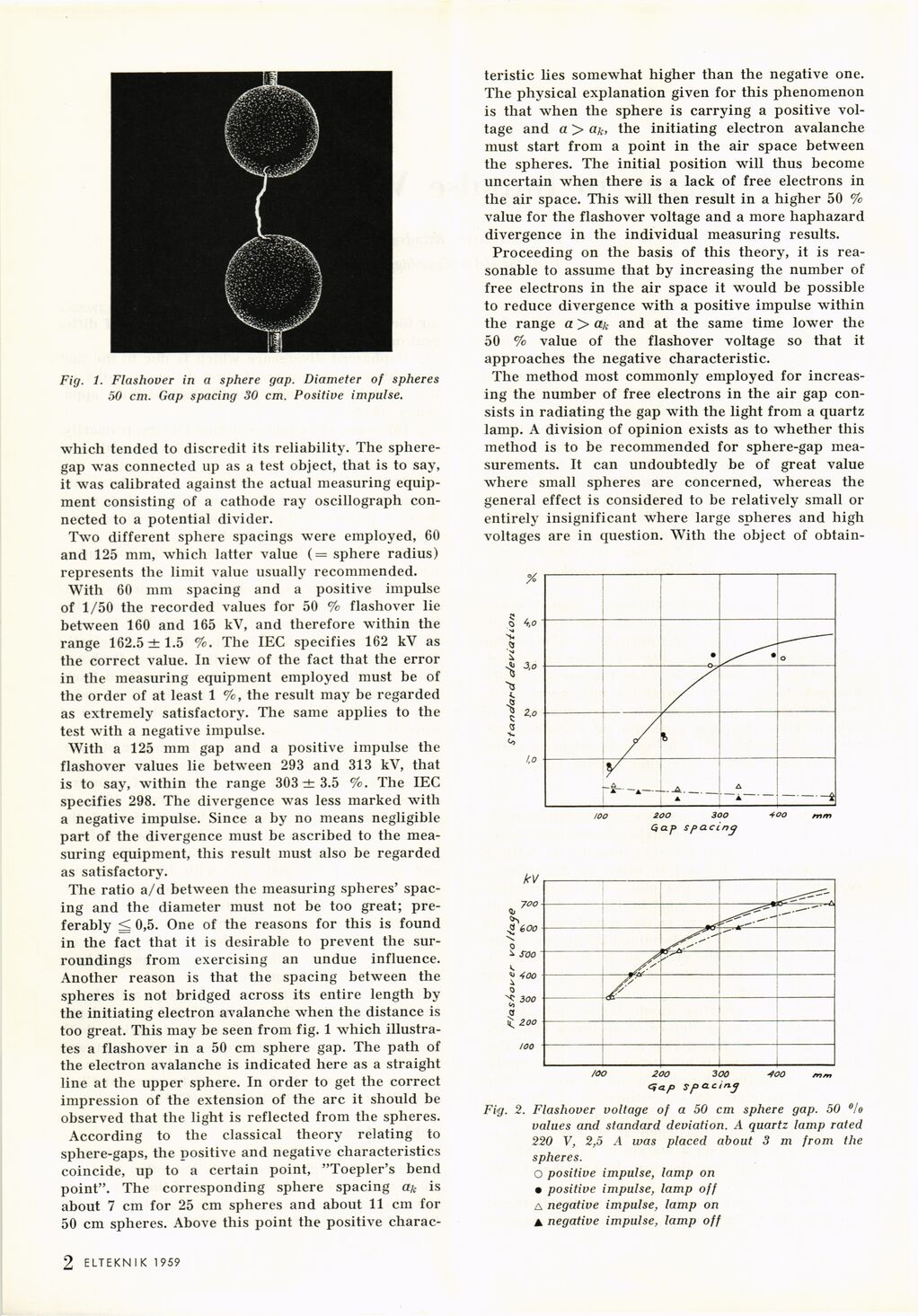
Full resolution (JPEG) - On this page / på denna sida - 1959, H. 1 - Accuracy in Impulse Voltage Tests, by Niels Knudsen

<< prev. page << föreg. sida << >> nästa sida >> next page >>
Below is the raw OCR text
from the above scanned image.
Do you see an error? Proofread the page now!
Här nedan syns maskintolkade texten från faksimilbilden ovan.
Ser du något fel? Korrekturläs sidan nu!
This page has never been proofread. / Denna sida har aldrig korrekturlästs.
Fig. 1. Flashover in a sphere gap. Diameter of spheres
50 cm. Gap spacing 30 cm. Positive impulse.
which tended to discredit its reliability. The
sphere-gap was connected up as a test object, that is to say,
it was calibrated against the actual measuring
equipment consisting of a cathode ray oscillograph
connected to a potential divider.
Two different sphere spacings were employed, 60
and 125 mm, which latter value ( — sphere radius)
represents the limit value usually recommended.
With 60 mm spacing and a positive impulse
of 1/50 the recorded values for 50 % flashover lie
between 160 and 165 kV, and therefore within the
range 162.5 ± 1.5 %. The IEC specifies 162 kV as
the correct value. In view of the fact that the error
in the measuring equipment employed must be of
the order of at least 1 %, the result may be regarded
as extremely satisfactory. The same applies to the
test with a negative impulse.
With a 125 mm gap and a positive impulse the
flashover values lie between 293 and 313 kV, that
is to say, within the range 303 ± 3.5 %. The IEC
specifies 298. The divergence was less marked with
a negative impulse. Since a by no means negligible
part of the divergence must be ascribed to the
measuring equipment, this result must also be regarded
as satisfactory.
The ratio a/d between the measuring spheres’
spacing and the diameter must not be too great;
preferably 0,5. One of the reasons for this is found
in the fact that it is desirable to prevent the
surroundings from exercising an undue influence.
Another reason is that the spacing between the
spheres is not bridged across its entire length by
the initiating electron avalanche when the distance is
too great. This may be seen from fig. 1 which
illustrates a flashover in a 50 cm sphere gap. The path of
the electron avalanche is indicated here as a straight
line at the upper sphere. In order to get the correct
impression of the extension of the arc it should be
observed that the light is reflected from the spheres.
According to the classical theory relating to
sphere-gaps, the positive and negative characteristics
coincide, up to a certain point, "Toepler’s bend
point". The corresponding sphere spacing ctk is
about 7 cm for 25 cm spheres and about 11 cm for
50 cm spheres. Above this point the positive charac-
teristic lies somewhat higher than the negative one.
The physical explanation given for this phenomenon
is that when the sphere is carrying a positive
voltage and a > ak, the initiating electron avalanche
must start from a point in the air space between
the spheres. The initial position will thus become
uncertain when there is a lack of free electrons in
the air space. This will then result in a higher 50 %
value for the flashover voltage and a more haphazard
divergence in the individual measuring results.
Proceeding on the basis of this theory, it is
reasonable to assume that by increasing the number of
free electrons in the air space it would be possible
to reduce divergence with a positive impulse within
the range a > ctk and at the same time lower the
50 % value of the flashover voltage so that it
approaches the negative characteristic.
The method most commonly employed for
increasing the number of free electrons in the air gap
consists in radiating the gap with the light from a quartz
lamp. A division of opinion exists as to whether this
method is to be recommended for sphere-gap
measurements. It can undoubtedly be of great value
where small spheres are concerned, whereas the
general effect is considered to be relatively small or
entirely insignificant where large spheres and high
voltages are in question. With the object of obtain-
Fig. 2. Flashover voltage of a 50 cm sphere gap. 50 °/o
values and standard deviation. A quartz lamp rated
220 V, 2,5 A was placed about 3 m from the
spheres.
O positive impulse, lamp on
• positive impulse, lamp off
A negative impulse, lamp on
A negative impulse, lamp off
ELTEKNIK 1959 1 2
<< prev. page << föreg. sida << >> nästa sida >> next page >>